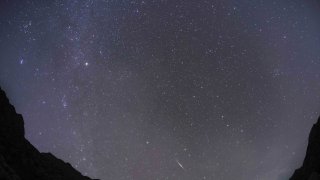
What's happening in the skies over North Texas this month? November holds some spectacular sights in the night and morning sky. Check out the list below.
THE LEONID METEOR SHOWER
November is known for its meteor showers. The Leonid meteor shower will run from November 6th through the 30th and peak around November 17th and 18th. Start looking for its radiant point in the constellation Leo shortly before midnight local time. Under ideal conditions, you could see up to 10 meteors an hour. The crescent Moon sets in the evening, leaving dark skies good for viewing.
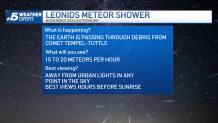
Get DFW local news, weather forecasts and entertainment stories to your inbox. Sign up for NBC DFW newsletters.
The Leonids are caused by debris from comet 55P/Tempel-Tuttle.
WHEN DOES THE INTERNATIONAL SPACE STATION FLY OVER NORTH TEXAS?
The International Space Station will make flybys across the North Texas sky this month. The ISS appears as a fast-moving star across the night sky.

The ISS rotates around the Earth at a speed of 17,500 mph. The ISS rotates about its center of mass at a rate of about four degrees per minute so that it will complete a full rotation once per orbit. This allows it to keep its belly towards the Earth. One revolution around the planet takes about 90 minutes (16 per day).
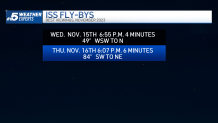
Also, the ISS sits at an altitude of 250 miles above the Earth. By the way, that is 1.32 million feet. Most commercial airplanes fly between 33,000 to 42,000 feet.
Weather Connection
Connecting you with your forecast and all the things that make North Texas weather unique.
HERE COMES JUPITER
On November 3rd, at 5:44 a.m. CDT., Jupiter will reach opposition - the moment when it lies exactly 180 degrees from the Sun.
Look for the planet in the constellation Aries. It will shine with a magnitude of -2.9, making it the brightest starlike object after “the morning star” Venus.
Jupiter's distance from the Earth varies from 336 million miles to 600 million miles.
MORNINGS WITH VENUS
If you're driving in the morning, a bright object will appear in the eastern sky before sunrise. Guess what…it is Venus.
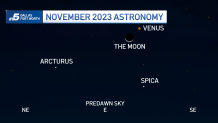
The moon will have a close conjunction with Venus on the morning of November 9th. It will remain a pre-dawn fixture in the sky through the rest of the year.
Venus's distance from the Earth varies from 24 million miles to 162 million miles.
THE SATURN POINT
Saturn maintains a quiet post among the faint stars of Aquarius this November. Early in November, the ringed planet lies due south at around 6:30 p.m. Central time. By month’s end, it will appear at its highest by 6 p.m. The moon will appear close to Saturn on the evenings of November 19th and 20th.
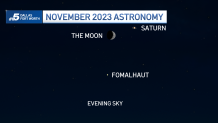
Saturn's distance varies from the Earth. When the two are closest, they lie approximately 746 million miles apart, or eight times the distance between the Earth and the sun.
At their most distant, when they lie on opposite sides of the Sun from one another, they are just over a billion miles apart, or 11 times the distance between the Earth and the Sun.
THE BEAVER MOON
November will feature a full moon. The Beaver Moon will make for a delight at the end of the month.
![[UGCDFW-CJ]Super Beaver Moon](https://media.nbcdfw.com/2019/09/effad5d7710941efad76dc253be7b2f2.jpg?quality=85&strip=all&resize=218%2C123)
The Beaver Moon gets its name from the time of the year when beavers begin to hide in their lodges, having stored enough food for the winter. The Beaver Moon will reach its peak at illumination (99.9%) across North Texas on November 27th at 12:07 a.m. CST.
Other names for November's full moon include Dark Moon, White Moon, Corn Moon, and Milk Moon.
Also, check out other phases of the moon this month. On November 21st at 3:01 p.m. CST., the moon will be at perigee, it is closest to the Earth for this orbit at 229,795 miles. On November 6th at 3:48 p.m. CST., the moon will be at apogee, its farthest from the Earth for this orbit at 251,388 miles.
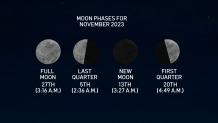
Please enjoy these events happening in the night sky this month. Until then... Texans, keep looking up!



